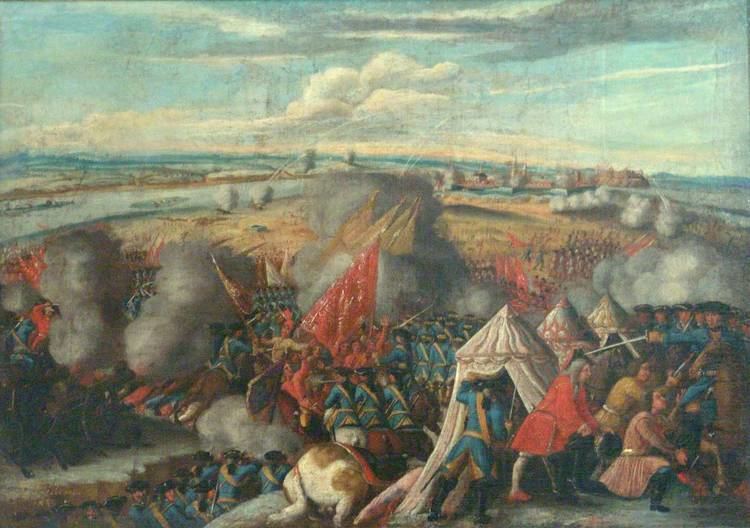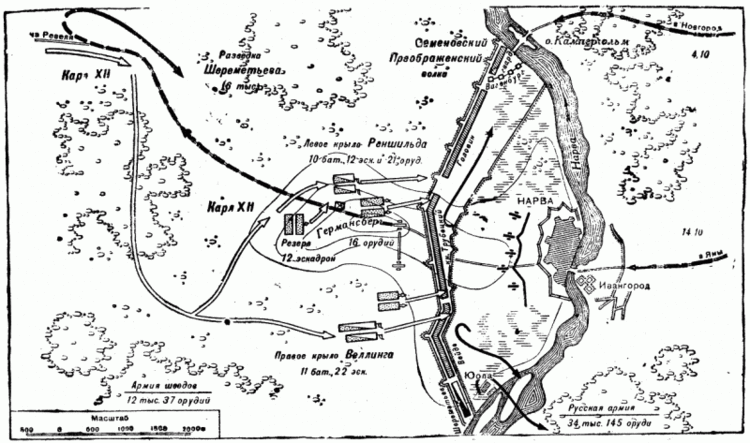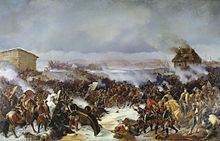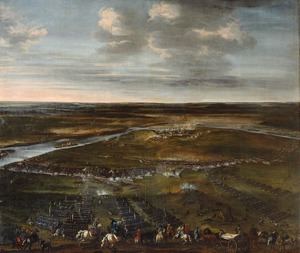Date 30 November 1700 | ||
 | ||
Narva garrison1,800 men,297 artillery piecesRelief force10,500 men,37 cannons 37,000 men,195 artillery pieces 667 killed,1,247 wounded more than 9,000 killed,20,000 captured Combatants Sweden, Swedish Empire, Tsardom of Russia Similar Great Northern War, Battle of Poltava, Battle of Kliszów, Battle of Fraustadt, Crossing of the Düna | ||
The Battle of Narva (Russian: Битва на Нарве; Swedish: Slaget vid Narva) on 19 November 1700 (30 November, N.S.) was an early battle in the Great Northern War. A Swedish relief army under Charles XII of Sweden defeated a Russian siege force three to four times its size. Before, Charles XII had forced Denmark-Norway to sign the Treaty of Travendal. Narva was not followed by further advances of the Swedish army into Russia; instead, Charles XII turned southward to expel August the Strong from Livonia and Poland-Lithuania. Tsar Peter the Great of Russia took Narva in a second battle in 1704.
Contents

Prelude

During the 17th century, Russia was less advanced technologically than the rest of Europe, a condition which extended to its armed forces. Despite this shortcoming, Peter the Great of Russia was keen to expand his territory by conquering parts of Sweden's Baltic provinces. Russia made a military alliance with Frederick IV, King of Denmark-Norway; and August the Strong, King of Poland-Lithuania and elector of Saxony, to wage war against Sweden. Whereupon all five countries attacked Sweden from several directions.

Charles XII, assisted by the Royal Navy and the Dutch Navy, first landed in Humlebæk north of Copenhagen and forced Denmark-Norway to leave the alliance in August 1700 (until 1709). He then moved part of the Swedish army across the Baltic Sea to Estonia where it was joined by Estonian and Finnish regiments of the Swedish army.
The new Russian tsar, Peter I, would drastically modernize Russia in the coming years, but the army with which he traveled in 1700 was still poorly drilled. Peter had employed foreign generals and officers to improve his armed forces, but they were still far from seasoned. Sweden, however, possessed a well-drilled and well-equipped army. Charles XII had one of the largest and most disciplined armies of northern Europe, and Peter envied its capabilities.

During November, Russian troops surrounded the city of Narva in Estonia (part of the Swedish Empire at the time), attempting to secure its surrender via siege. A Saxon-Polish army commanded by August II and Steinau was outside Riga in Swedish Livonia. The Saxon-Polish army, however, had gone into winter camp south of the river Daugava so Charles XII decided to deal with the more immediate Russian threat against Narva, which was under siege by Peter's forces.
Battle

On 19 (OS) or 30 (NS) November 1700 (20 November in the Swedish transitional calendar), Charles XII positioned his 8,000 men (another 2,500 men were garrisoned in the city and would take part in the battle at a later stage) opposite the besieging Russian army of about 34,000 to 40,000 troops.

The Swedish army was commanded personally by Charles XII, assisted by General Carl Gustav Rehnskiöld. The Russian forces were commanded by Peter and Charles Eugène de Croy. Claiming important domestic events in Russia to which he was required to attend, Peter had left Narva just days before and was therefore not present during the actual fighting. He trusted that his commanders would draw success from the battle and presumed that Charles would not immediately attack his well fortified and numerically superior force. Some interpretations view his departure from Narva days before the battle an act of cowardice; most of Europe mocked the Tsar after the battle for his departure. However, some scholars believe this accusation has little merit, as reportedly the Tsar had placed himself in physical danger too many times previously for his flight to be out of cowardice.
For much of the day, a blizzard engulfed both armies, making attacks impossible. However, at midday, the winds changed and the snowstorm blew directly into the eyes of the Russians. Charles saw his opportunity and advanced on the Russian army under cover of the weather. The Swedes attacked in two columns, quickly broke through the Russian lines, cutting them in three, and rounded them up. At one crucial point, a bridge over the Narova River collapsed under retreating Russian troops: The stampede led to the overall losses of 6,000–18,000 Russians, depending on sources. The remainder surrendered.
The Russian surrender brought to Charles XII's army all of Peter's cannons, and many muskets and military supplies. This left Russia's remaining armed forces with little equipment. If Sweden had invaded Russia immediately after Narva, Peter would have been almost powerless to stop them.
Russian memorial
In 1900, 200 years after the battle of Narva, the Preobrazhensky and Semyonovsky regiments initiated the construction of a memorial to the Russian soldiers who had fallen in the Battle of Narva (photo left). The memorial consists of a granite pedestal with a cross on top, placed on a mound of earth. The inscription says: "Our heroic ancestors who fell in November 1700."
Victory monument
On 20 November 2000 the Swedish Minister for Foreign Affairs, Lena Hjelm Wallén inaugurated a new memorial monument to celebrate the victory (photo left). Erected with an economic contribution from the Swedish Institute, it replaced an older memorial, erected in 1936, which disappeared during the Second World War. The monument is surmounted by a "Swedish lion", his left paw resting on a ball engraved with the Three Crowns of Sweden. It stands on a pedestal of granite. The Latin inscription on the pedestal reads "MDCC" (1700) and "Svecia memor" ("Sweden remembers").
Second battle
Four years after the first battle of Narva, Peter I marched again in an attempt to capture Narva. Marshal Boris Sheremetev's force of 20,000 captured Tartu on 24 June. Sheremetev then besieged Narva, where the garrison was under Commandant Major-General Henning Rudolf Horn af Ranzien and consisted of 3,800 infantry and 1,300 cavalry. The Russians captured Narva on 20 August 1704 and massacred some of its Swedish inhabitants before Peter I stopped them. Horn, several officers and a large number of Swedish soldiers were captured, with about 3,200 casualties while the Russians lost up to 3,000 men during the siege and the battle.
